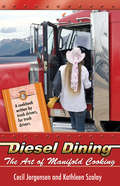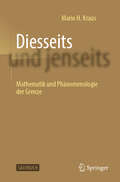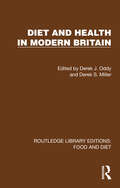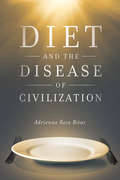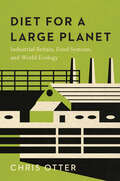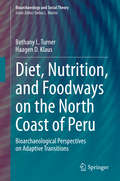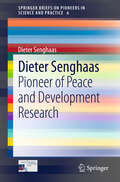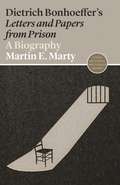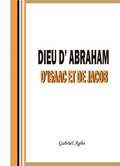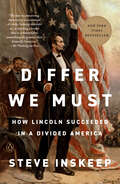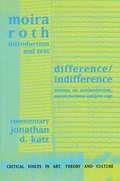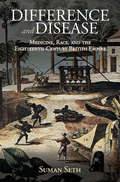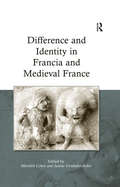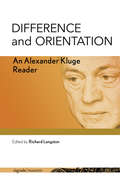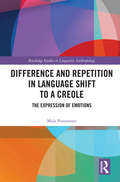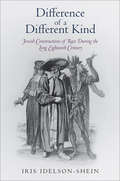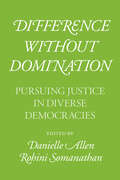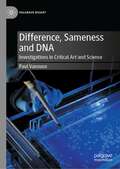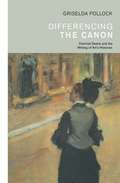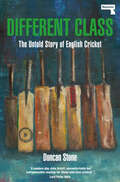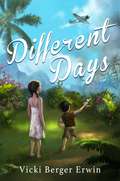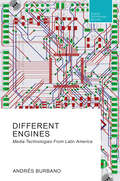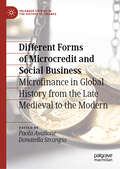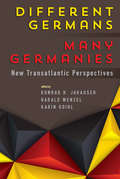- Table View
- List View
Diesel Dining: The Art of Manifold Cooking
by Cecil Jorgensen Kathleen SzalayDiesel Dining: The Art of Manifold Cooking is for hungry truck drivers. Hard working people not having the luxury of being at home, and wanting something at the end of a long day resembling a home-cooked dinner. Diesel Dining: The Art of Manifold Cooking teaches you how to prepare good, healthy, hot, affordable meals. Diesel Dining: The Art of Manifold Cooking is guaranteed to save you thousands of dollars a year by removing the temptation and impulse buying of overpriced fast food products when you are famished and too exhausted to cook. Diesel Dining: The Art of Manifold Cooking offers a variety of recipes you can try cooking on your manifold. It also includes tips, tricks, stories, and trucking folklore. If you're a long haul trucker, and you want to enjoy a home-cooked, hot, meat and potatoes dinner at the end of your day's drive, then Diesel Dining: The Art of Manifold Cooking is the one and only cookbook you'll ever need. You'll never see Diesel Dining: The Art of Manifold Cooking in a typical homemaker's kitchen, since its premise is based on using your truck's diesel engine to cook your meals. Soon, this book will be dog-eared and stained with a variety of sauces, as it sits within easy reach by your interstate maps and daily log book.
Diesseits und jenseits: Mathematik und Phänomenologie der Grenze
by Mario H. KrausDieses Buch behandelt Grenzen als allgegenwärtige Erscheinungen verschiedener Lebenswelten. Grenzen markieren stets Zweiseitigkeit: Es gibt genau zwei Seiten, auf beiden ist oder geschieht jeweils etwas anderes, aber niemals Nichts. Der Autor arbeitet anhand verschiedenster Beispiele wesentliche Gemeinsamkeiten und Unterschiede verschiedener Grenzbegriffe in räumlichen, zeitlichen und gesellschaftlichen Kontexten heraus. Er entwirft einen fachübergreifenden Grenzbegriff, der Ausgangspunkt für eine Limologie, eine Lehre von den Grenzen, sein kann. Die Mathematik hilft dabei, zugrundeliegende Gesetzmäßigkeiten zu verstehen; die Phänomenologie vermittelt zwischen Theorie und Praxis. Das Buch bietet somit wertvolle Impulse für fachübergreifend Interessierte u.a. mit Hintergründen in Mathematik, Physik, Geographie, Architektur, Soziologie, Psychologie oder Philosophie.
Diet and Health in Modern Britain (Routledge Library Editions: Food and Diet)
by Derek J. Oddy Derek S. MillerOriginally published in 1985, Diet and Health in Modern Britain examines the changes in diet and health in Britain during the rapid social development of the late nineteenth and early twentieth centuries. It is particularly concerned with the ways in which the problems of urban life were ameliorated. How was infant and child mortality reduced? How did family life go on in conditions where income was low and sometimes intermittent, where protected water supplies and proper sanitation were not available, and where food preservation and food technology were still limited? How did the state devise diets for those in its care? What were the choices available for consumers?The contributors to this book were historians and nutritionists and this gives a strong interdisciplinary flavour to the volume. Many of the problems encountered during British urban development were being experienced in the developing world at the time. The way in which Britain coped with the health hazards of late-nineteenth-century urban squalor had much to tell those concerned with similar problems in contemporary cities in the developing world. The book makes clear that life in Britain in the late-nineteenth and early-twentieth centuries and life in the developing world at the time represented similar stages of the process of demographic transition.
Diet and the Disease of Civilization
by Adrienne Rose BitarDiet books contribute to a $60-billion industry as they speak to the 45 million Americans who diet every year. Yet these books don’t just tell readers what to eat: they offer complete philosophies about who Americans are and how we should live. Diet and the Disease of Civilization interrupts the predictable debate about eating right to ask a hard question: what if it’s not calories—but concepts—that should be counted?Cultural critic Adrienne Rose Bitar reveals how four popular diets retell the “Fall of Man” as the narrative backbone for our national consciousness. Intensifying the moral panic of the obesity epidemic, they depict civilization itself as a disease and offer diet as the one true cure. Bitar reads each diet—the Paleo Diet, the Garden of Eden Diet, the Pacific Island Diet, the detoxification or detox diet—as both myth and manual, a story with side effects shaping social movements, driving industry, and constructing fundamental ideas about sickness and health. Diet and the Disease of Civilization unearths the ways in which diet books are actually utopian manifestos not just for better bodies, but also for a healthier society and a more perfect world.
Diet for a Large Planet: Industrial Britain, Food Systems, and World Ecology
by Chris OtterWe are facing a world food crisis of unparalleled proportions. Our reliance on unsustainable dietary choices and agricultural systems is causing problems both for human health and the health of our planet. Solutions from lab-grown food to vegan diets to strictly local food consumption are often discussed, but a central question remains: how did we get to this point? In Diet for a Large Planet, Chris Otter goes back to the late eighteenth century in Britain, where the diet heavy in meat, wheat, and sugar was developing. As Britain underwent steady growth, urbanization, industrialization, and economic expansion, the nation altered its food choices, shifting away from locally produced plant-based nutrition. This new diet, rich in animal proteins and refined carbohydrates, made people taller and stronger, but it led to new types of health problems. Its production also relied on far greater acreage than Britain itself, forcing the nation to become more dependent on global resources. Otter shows how this issue expands beyond Britain, looking at the global effects of large agro-food systems that require more resources than our planet can sustain. This comprehensive history helps us understand how the British played a significant role in making red meat, white bread, and sugar the diet of choice—linked to wealth, luxury, and power—and shows how dietary choices connect to the pressing issues of climate change and food supply.
Diet, Nutrition, and Foodways on the North Coast of Peru: Bioarchaeological Perspectives on Adaptive Transitions (Bioarchaeology and Social Theory)
by Bethany L. Turner Haagen D. KlausThis book synthesizes in-depth bioarchaeological research into diet, subsistence regimes, and nutrition—and corresponding insights into adaptation, suffering, and resilience—among indigenous north-coastal Peruvian communities from early agricultural through European colonial periods.The Spanish invasion and colonization of Andean South America left millions dead, landscapes transformed, and traditional ways of life annihilated. However, the nature and magnitude of these changes were far from uniform. By the time the Spanish arrived, over four millennia of complex societies had emerged and fallen, and in the 16th century, the region was home to the largest and most expansive indigenous empire in the western hemisphere.Decades of Andean archaeological and ethnohistorical research have explored the incredible sophistication of regional agropastoral traditions, the importance of food and feasting as mechanisms of control, and the significance of maritime economies in the consolidation of complex polities. Bioarchaeology is particularly useful in studying these processes. Beyond identifying what resources were available and how they were prepared, bioarchaeological methods provide unique opportunities and humanized perspectives to reconstruct what individuals actually ate, and whether their diets changed within their own lifespans.
Dieter Senghaas
by Dieter SenghaasDieter Senghaas, professor emeritus of international relations, University of Bremen, was one of most innovative contemporary German social scientists, with major contributions on peace and development research and on music and peace. He was awarded many prizes: the International Peace Research Award (1987), Göttingen Peace Prize (1999), Culture and Peace Prize of the Villa Ichon in Bremen (2006), and the Leopold-Kohr Prize of the Austrian Ministry of Science and Research (2010). In addition to his autobiographic notes and his selected bibliography, this book offers a global audience five key texts by D. Senghaas (1974-2009): Towards an Analysis of Threat Policy in International Relations; Friedrich List and the Basic Problems of Development; Developing the Definitions of Perpetual Peace ('para pacem'): Through What and How is Peace Constituted Today?; Sounds of Peace: On Peace Fantasies and Peace Offerings in Classical Music; and Enhancing Human Rights - A Contribution to Viable Peace.
Dietrich Bonhoeffer's "Letters and Papers from Prison": A Biography (Lives of Great Religious Books #4)
by Martin E MartyFor fascination, influence, inspiration, and controversy, Dietrich Bonhoeffer's Letters and Papers from Prison is unmatched by any other book of Christian reflection written in the twentieth century. A Lutheran pastor and theologian, Bonhoeffer spent two years in Nazi prisons before being executed at age thirty-nine, just a month before the German surrender, for his role in the plot to kill Hitler. The posthumous Letters and Papers from Prison has had a tremendous impact on both Christian and secular thought since it was first published in 1951, and has helped establish Bonhoeffer's reputation as one of the most important Protestant thinkers of the twentieth century. In this, the first history of the book's remarkable global career, National Book Award-winning author Martin Marty tells how and why Letters and Papers from Prison has been read and used in such dramatically different ways, from the cold war to today. In his late letters, Bonhoeffer raised tantalizing questions about the role of Christianity and the church in an increasingly secular world. Marty tells the story of how, in the 1960s and the following decades, these provocative ideas stirred a wide range of thinkers and activists, including civil rights and antiapartheid campaigners, "death-of-God" theologians, and East German Marxists. In the process of tracing the eventful and contested history of Bonhoeffer's book, Marty provides a compelling new perspective on religious and secular life in the postwar era.
Dietrich Bonhoeffer's Letters and Papers from Prison A Biography
by Martin E. MartyFor fascination, influence, inspiration, and controversy, Dietrich Bonhoeffer's Letters and Papers from Prison is unmatched by any other book of Christian reflection written in the twentieth century. A Lutheran pastor and theologian, Bonhoeffer spent two years in Nazi prisons before being executed at age thirty-nine, just a month before the German surrender, for his role in the plot to kill Hitler. The posthumous Letters and Papers from Prison has had a tremendous impact on both Christian and secular thought since it was first published in 1951, and has helped establish Bonhoeffer's reputation as one of the most important Protestant thinkers of the twentieth century. In this, the first history of the book's remarkable global career, National Book Award-winning author Martin Marty tells how and why Letters and Papers from Prison has been read and used in such dramatically different ways, from the cold war to today. In his late letters, Bonhoeffer raised tantalizing questions about the role of Christianity and the church in an increasingly secular world. Marty tells the story of how, in the 1960s and the following decades, these provocative ideas stirred a wide range of thinkers and activists, including civil rights and antiapartheid campaigners, "death-of-God" theologians, and East German Marxists. In the process of tracing the eventful and contested history of Bonhoeffer's book, Marty provides a compelling new perspective on religious and secular life in the postwar era.
Dieu d'Abraham, d'Isaac et de Jacob
by Gabriel Agbo Dang NkouLes promesses de l'alliance de Dieu n'échouent pas. Ce livre est écrit pour vous aider à réaliser toutes les promesses de Dieu pour votre vie. C'est une étude minutieuse et détaillée, avec des témoignages personnels, sur la capacité et la volonté de Dieu d'accomplir toutes ses paroles envers nous. Il a dit qu'il veille sur ses paroles pour les accomplir. Ici, nous examinerons de manière critique la dynamique d'une promesse divine; comment elle est établie, entretenue et nourrie à la réalisation. Chaque promesse d'alliance a son commencement, son calendrier et ses conditions. Nous devons toujours le savoir pour être en mesure de parfaitement et confortablement s'adapter à la volonté de Dieu pour notre vie. En effet, toute chose est possible avec Dieu!
Differ We Must: How Lincoln Succeeded in a Divided America
by Steve InskeepAn instant New York Times bestsellerA compelling and nuanced exploration of Abraham Lincoln&’s political acumen, illuminating a great politician&’s strategy in a country divided—and lessons for our own disorderly presentIn 1855, with the United States at odds over slavery, the lawyer Abraham Lincoln wrote a note to his best friend, the son of a Kentucky slaveowner. Lincoln rebuked his friend for failing to oppose slavery. But he added: &“If for this you and I must differ, differ we must,&” and said they would be friends forever. Throughout his life and political career, Lincoln often agreed to disagree. Democracy demanded it, since even an adversary had a vote. The man who went on to become America&’s sixteenth president has assumed many roles in our historical consciousness, but most notable is that he was, unapologetically, a politician. And as Steve Inskeep argues, it was because he was willing to engage in politics—meeting with critics, sometimes working with them and other times outwitting them—that he was able to lead a social revolution.In Differ We Must, Inskeep illuminates Lincoln&’s life through sixteen encounters, some well-known, some obscure, but all imbued with new significance here. Each interaction was with a person who differed from Lincoln, and in each someone wanted something from the other. While Lincoln didn&’t always change his critics&’ beliefs—many went to war against him—he did learn how to make his beliefs actionable. He told jokes, relied on sarcasm, and often made fun of himself—but behind the banter was a distinguished storyteller who carefully chose what to say and what to withhold. He knew his limitations and, as history came to prove, he knew how to prioritize. Many of his greatest acts came about through his engagement with people who disagreed with him—meaning that in these meetings, Lincoln became the Lincoln we know.As the host of NPR&’s Morning Edition for almost two decades, Inskeep has mastered the art of bridging divides and building constructive debate in interviews; in Differ We Must, he brings his skills to bear on a prior master, forming a fresh and compelling narrative of Lincoln&’s life. With rich detail and enlightening commentary, Inskeep expands our understanding of a politician who held strong to his moral compass while navigating between corrosive political factions, one who began his career in the minority party and not only won the majority but succeeded in uniting a nation.
Difference / Indifference: Musings on Postmodernism, Marcel Duchamp and John Cage (Critical Voices in Art, Theory and Culture)
by Moira Roth Jonathan D KatzFirst Published in 1999. Routledge is an imprint of Taylor & Francis, an informa company.
Difference and Disease: Medicine, Race, and the Eighteenth-Century British Empire (Global Health Histories)
by Suman SethDifference and Identity in Francia and Medieval France
by Justine Firnhaber-Baker Meredith CohenDifference in medieval France was not solely a marker for social exclusion, provoking feelings of disgust and disaffection, but it could also create solidarity and sympathy among groups. Contributors to this volume address inclusion and exclusion from a variety of perspectives, ranging from ethnic and linguistic difference in Charlemagne's court, to lewd sculpture in Béarn, to prostitution and destitution in Paris. Arranged thematically, the sections progress from the discussion of tolerance and intolerance, through the clearly defined notion of foreignness, to the complex study of stranger identity in the medieval period. As a whole the volume presents a fresh, intriguing perspective on questions of exclusion and belonging in the medieval world.
Difference and Orientation: An Alexander Kluge Reader (signale|TRANSFER: German Thought in Translation)
by Alexander KlugeAlexander Kluge is one of contemporary Germany's leading intellectuals and artists. A key architect of the New German Cinema and a pioneer of auteur television programming, he has also cowritten three acclaimed volumes of critical theory, published countless essays and numerous works of fiction, and continues to make films even as he expands his video production to the internet. Despite Kluge's five decades of work in philosophy, literature, television, and media politics, his reputation outside of the German-speaking world still largely rests on his films of the 1960s, 70s, and 80s. With the aim of introducing Kluge's heterogeneous mind to an Anglophone readership, Difference and Orientation assembles thirty of his essays, speeches, glossaries, and interviews, revolving around the capacity for differentiation and the need for orientation toward ways out of catastrophic modernity. This landmark volume brings together some of Kluge's most fundamental statements on literature, film, pre- and post-cinematic media, and social theory, nearly all for the first time in English translation. Together, these works highlight Kluge's career-spanning commitment to unorthodox, essayistic thinking.
Difference and Repetition in Language Shift to a Creole: The Expression of Emotions (Routledge Studies in Linguistic Anthropology)
by Maïa PonsonnetIn today’s global commerce and communication, linguistic diversity is in steady decline across the world as speakers of smaller languages adopt dominant forms. While this phenomenon, known as ‘language shift’, is usually regarded as a loss, this book adopts a different angle and addresses the following questions: What difference does using a new language make to the way speakers communicate in everyday life? Can the grammatical and lexical architectures of individual languages influence what speakers express? In other words, to what extent does adopting a new language alter speakers’ day-to-day communication practices, and in turn, perhaps, their social life and world views? To answer these questions, this book studies the expression of emotions in two languages on each side of a shift: Kriol, an English-based creole spoken in northern Australia, and Dalabon (Gunwinyguan, non-Pama-Nyungan), an Australian Aboriginal language that is being replaced by Kriol. This volume is the first to explore the influence of the formal properties of language on the expression of emotions, as well as the first description of the linguistic encoding of emotions in a creole language. The cross-disciplinary approach will appeal to linguists, psychologists, anthropologists and other social scientists.
Difference of a Different Kind: Jewish Constructions of Race During the Long Eighteenth Century (Jewish Culture and Contexts)
by Iris Idelson-SheinEuropean Jews, argues Iris Idelson-Shein, occupied a particular place in the development of modern racial discourse during the late seventeenth and early eighteenth centuries. Simultaneously inhabitants and outsiders in Europe, considered both foreign and familiar, Jews adopted a complex perspective on otherness and race. Often themselves the objects of anthropological scrutiny, they internalized, adapted, and revised the emerging discourse of racial difference to meet their own ends.Difference of a Different Kind explores Jewish perceptions and representations of otherness during the formative period in the history of racial thought. Drawing on a wide range of sources, including philosophical and scientific works, halakhic literature, and folktales, Idelson-Shein unfolds the myriad ways in which eighteenth-century Jews imagined the "exotic Other" and how the evolving discourse of racial difference played into the construction of their own identities. Difference of a Different Kind offers an invaluable view into the ways new religious, cultural, and racial identities were imagined and formed at the outset of modernity.
Difference without Domination: Pursuing Justice in Diverse Democracies
by Danielle Allen Rohini SomanathanAround the globe, democracy appears broken. With political and socioeconomic inequality on the rise, we are faced with the urgent question of how to better distribute power, opportunity, and wealth in diverse modern societies. This volume confronts the dilemma head-on, exploring new ways to combat current social hierarchies of domination. Using examples from the United States, India, Germany, and Cameroon, the contributors offer paradigm-changing approaches to the concepts of justice, identity, and social groups while also taking a fresh look at the idea that the demographic make-up of institutions should mirror the make-up of a populace as a whole. After laying out the conceptual framework, the volume turns to a number of provocative topics, among them the pernicious tenacity of implicit bias, the logical contradictions inherent to the idea of universal human dignity, and the paradoxes and problems surrounding affirmative action. A stimulating blend of empirical and interpretive analyses, Difference without Domination urges us to reconsider the idea of representation and to challenge what it means to measure equality and inequality.
Difference, Sameness and DNA: Investigations in Critical Art and Science (Palgrave BioArt)
by Paul VanouseThis book chronicles over two decades of critical, artistic investigations by Paul Vanouse. His bio-media artwork utilizes the tools of the life sciences reflexively, to challenge tropes and cultural politics surrounding DNA, biotechnology, and life itself. DNA has been called a “Truth Machine”, “God’s Blueprint”, the “Code of Codes” and the “Book of Life”. Vanouse’s work explores questions at the heart of such evocative metaphor and hyperbole: how does DNA link us together, how does it differentiate us and how are the grand metaphors, which grant DNA complete centrality, misconstruing the complexity of life. Furthermore, how do technologies of genetic typing and identification fit within a broader cultural and political history of difference making, particularly the construction of race. Melding critical theory, artist’s manifesto, participatory observation and histories of the sciences, this book offers insight into both an artistic practice and the bio-techno-sciences it interrogates.
Differencing the Canon: Feminism and the Writing of Art's Histories (Re Visions Ser.)
by Griselda PollockIn this major book, Griselda Pollock engages boldly in the culture wars over `what is the canon?` and `what difference can feminism make?` Do we simply reject the all-male line-up and satisfy our need for ideal egos with an all women litany of artistic heroines? Or is the question a chance to resist the phallocentric binary and allow the ambiguities and complexities of desire - subjectivity and sexuality - to shape the readings of art that constantly displace the present gender demarcations?
Different Class: The Untold Story of English Cricket
by Duncan StoneIn telling the story of cricket from the bottom up, Different Class demonstrates how the "quintessentially English" game has done more to divide, rather than unite, the English.In 1963, the West Indian Marxist C.L.R. James posed the deceptively benign question: "What do they know of cricket, who only cricket know?"A challenge to the public to re-consider cricket and its meaning by placing the game in its true social, political and economic context, James was, all too subtly, attempting to counter the game&’s orthodox history that, he argued, had played a key role in the formation of national culture. As a consequence, he failed, and the history of cricket in England has retained the same stresses and lineaments as it did a century ago — until now.In examining recreational rather than professional (first-class) cricket, Different Class does not simply challenge the widely accepted orthodoxy of English cricket, it demonstrates how the values and belief systems at its heart were, under the guise of amateurism, intentionally developed in order to divide the English along class lines at every level of the game. If the creation of opposing class-based cricket cultures in the North and South of England grew out of this process, the institutional structures developed by those in charge of English cricket continue to discriminate. But, as much as the exclusion of Black and South Asian cricketers from the recreational mainstream is the most obvious example, it is social class that remains the greatest barrier to participation in what used to be the national game.
Different Days
by Vicki Berger ErwinTwelve-year-old Rosie is fiercely proud to be an American, and has a happy life with her family in their comfortable home in sunny Honolulu, Hawaii.Then, on the morning of December 7, 1941, Pearl Harbor is bombed and everything changes.Rosie's parents, both of German descent -- but American citizens who have lived in Hawaii nearly all their lives -- are immediately rounded up by the military. Though they've done nothing wrong, they are interrogated as German spies and imprisoned, and all the family's possessions are seized. Within days, Rosie and her brother are abandoned and homeless. A relative begrudgingly takes them in until their beloved aunt (who was also rounded up, but released) comes for them. Even then, the children's once-idyllic lives are filled with darkness and discrimination as they can only wait -- and hope -- for their parents' safe return.Based on true events, Different Days tells the story of a little-known aspect of World War II: the Internment of German Americans.
Different Engines: Media Technologies From Latin America (Routledge Research in Design, Technology and Society)
by Andrés BurbanoDifferent Engines investigates the emergence of technologies in Latin America to create images, sounds, video games, and physical interactions. The book contributes to the construction of a historiographical and theoretical framework for understanding the work of creators who have been geographically and historically marginalized through the study of five exemplary and yet relatively unknown artifacts built by engineers, scientists, artists, and innovators. It offers a broad and detailed view of the complex and sometimes unlikely conditions under which technological innovation is possible and of the problematic logics under which these innovations may come to be devalued as historically irrelevant. Through its focus on media technologies, the book presents the interactions between technological and artistic creativity, working towards a wider understanding of the shifts in both fields that have shaped current perceptions, practices, and design principles while bringing into view the personal, social, and geopolitical singularities embodied by particular devices. It will be an engaging and insightful read for scholars, researchers, and students across a wide range of disciplines, such as media studies, art and design, architecture, cultural history, and the digital humanities.
Different Forms of Microcredit and Social Business: Microfinance in Global History from the Late Medieval to the Modern (Palgrave Studies in the History of Finance)
by Donatella Strangio Paola AvalloneThis edited collection discusses the evolution of microfinance and social business from the late medieval period to the modern era. The book fills a gap in financial history by exploring lesser-known, informal forms of credit granted to the poorest people, which have often not been recorded in writing. The book highlights the particularly innovative forms of credit developed in Italy, but also includes global contributions on the presence of microfinance and social business across Europe, Asia, and the Middle East. This book illuminates for different countries and periods forms of financial assistance available for those not deemed as creditworthy – whether through the institution of the Monti di Pietà, an Italian credit instrument of the late Middle Ages, loans granted by shopkeepers, pawnbroking, or mutual aid distributed by lottery or religious institutions. The geographical diversity of the chapters enables comparative analyses to be drawn between different forms of credit and financial systems as they developed over a long period. The research presented offers new perspectives for contemporary microfinance, as well as reconstructing the experience of those living in poverty in a range of social, economic and religious contexts. The book will be of interest to a broad readership, including those working in financial, economic and social history.
Different Germans, Many Germanies: New Transatlantic Perspectives
by Konrad H. Jarausch Harald Wenzel Karin GoihlAs much as any other nation, Germany has long been understood in terms of totalizing narratives. For Anglo-American observers in particular, the legacies of two world wars still powerfully define twentieth-century German history, whether through the lens of Nazi-era militarism and racial hatred or the nation's emergence as a "model" postwar industrial democracy. This volume transcends such common categories, bringing together transatlantic studies that are unburdened by the ideological and methodological constraints of previous generations of scholarship. From American perceptions of the Kaiserreich to the challenges posed by a multicultural Europe, it argues for-and exemplifies-an approach to German Studies that is nuanced, self-reflective, and holistic.
